Edith Dimock
Edith Dimock (February 16, 1876 – October 28, 1955) was an American painter. Her work was exhibited at the 1913 Armory Show in New York. She married fellow artist, William Glackens, but continued to use her maiden name professionally after the marriage.
Edith Dimock Glackens | |
|---|---|
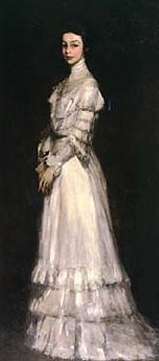 Robert Henri, Portrait of Edith Dimock Glackens, ca. 1902–4, Sheldon Museum of Art | |
| Born | Edith Dimock February 16, 1876 |
| Died | October 28, 1955 (aged 79) |
| Nationality | American |
| Education | Art Students League, William Merritt Chase |
| Spouse(s) | William Glackens |
Personal life
Dimock was born in 1876 in Hartford, Connecticut.[1] She was given the nickname of "Teed", and was the daughter of Ira Dimock, a silk merchant based in Connecticut, and older sister of Stanley, Harold Edwin and Florence Irene Dimock (1889–1962).[2][3] Dimock developed an interest in art in her childhood and began her education in art in New York in her 20s against the wishes of her parents.[4] On February 16, 1904 she married painter William Glackens in her family's Vanderbilt Hill mansion,[5] originally built for Cornelius Vanderbilt.[6]
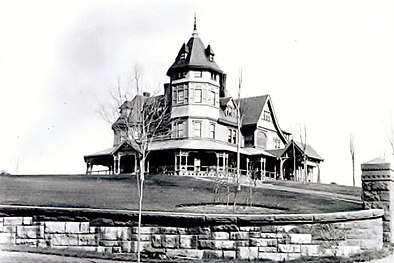 Ira Dimock's house on Vanderbilt Hill, Hartford, Connecticut where Edith Dimock was raised and married (built in 1879, razed in 1920)
Ira Dimock's house on Vanderbilt Hill, Hartford, Connecticut where Edith Dimock was raised and married (built in 1879, razed in 1920)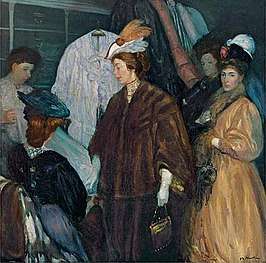 William Glackens, The Shoppers (1907–8; Chrysler Museum of Art, Norfolk, Virginia). The central figure is Edith Dimock.
William Glackens, The Shoppers (1907–8; Chrysler Museum of Art, Norfolk, Virginia). The central figure is Edith Dimock.
As a wedding present, Robert Henri painted portraits of the bride and groom. Edith's portrait was started in 1902. In it, she was described as "still a demure socialite from Hartford" by author Bennard Perlman.[7] Until they could find a larger place, they first lived in a one-room apartment in the Sherman Building in New York City.[5] They then lived at 3 Washington Square North.[8] Following the marriage, "she devoted her time and energies to her family."[1] Their son Ira, born in 1907, was a writer who wrote two books about his father. In 1913 Dimock gave birth to their daughter, Lenna,[9][10] an artist. Lenna and Edith were favored models for William Glackens.[4] From 1911 to 1917, Dimock and her family spent the summers at Belport on Long Island, where her husband, William Glackens, painted beach scenes.[11][12] Artists and good friends May Preston and James Moore Preston often spent the summers there and traveled with the Glackens to Europe.[12]
Dimock was an honorary secretary of the National Union of Women's Suffrage Societies in 1911 and 1915.[13] In 1913 she marched in the large suffrage parade in New York, along with a group of other artists.[14]
Her husband died in 1938. Dimock died October 28, 1955 at her home in Hartford.[9]
Career
She studied at the Art Students League between 1895 and 1899[1][7] with William Merritt Chase. Dimock described her classes at the Art Students League:
In a room innocent of ventilation, the job was to draw Venus (just the head) and her colleagues. We were not allowed to hitch bodies to the heads——yet. The dead white plaster of Paris was a perfect inducer of eye-strain, and was called "The Antique." One was supposed to work from "The Antique" for two years. The advantage of "The Antique" was that all these gods and athletes were such excellent models: there never was the twitch of an iron-bound muscle. Venus never batted her hard-boiled egg eye, and the Discus-thrower never wearied. They were also cheap models and did not have to be paid union rates.
— Edith Dimock[15]
She then studied with Chase at the New York School of Art.[5][7] She shared a studio in the Sherwood building,[16] and artist's cooperative building on 57th Street in Manhattan,[12] with May Preston and another artist. The three women held weekly open houses and became known as the lively "Sherwood Sisters". The women gathered with male artists from the Ashcan School, including William Glackens and James Moore Preston, at Mouquin's and Cafe Francis.[12][16] Following her marriage in 1904, Dimock continued to sign her works using her maiden name.[7]
In 1904 her works were shown at the American Water Color Society exhibition:
Miss Dimock is not unorthodox at all. She comes to her world very unconventionally, free from pictorial prejudice, and with a purpose which is not complicated by unsettled notions. Her attitude to life is the precise antithesis of the attitude that prevails in this exhibition, where unattached sentiment rules and the 'picture instinct' is so much too strong for original observation. Here is an artist with a definite aim, a keen fresh vision.
— Evening Star review[7]
She made watercolor genre scenes "though charming, often displayed a caustic sense of humor."[4]
She illustrated Grace Van Rensselaer Dwight's children's book of nine short stories, The yellow cat and her friends which was published in 1905[17] and Kate Forrest Oswell's Stories Grandmother Told, which was published in 1912.[18]
Her works were shown in 1908 with seven other painters at the Macbeth Galleries at the Ashcan School.[19] Dimock exhibited at the New York Armory Show of 1913, where she showed 8 works, Sweat Shop Girls in the Country, Mother and Daughter, and six paintings, all entitled Group.[20]
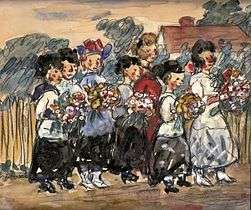 Sweat Shop Girls in the Country, ca. 1913. Watercolor, gouache, and charcoal on paper
Sweat Shop Girls in the Country, ca. 1913. Watercolor, gouache, and charcoal on paper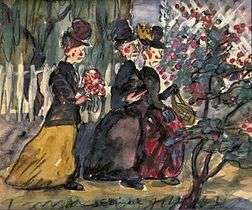 Three Women, ca. 1913. Watercolor, gouache, and charcoal on paper
Three Women, ca. 1913. Watercolor, gouache, and charcoal on paper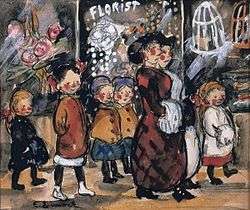 Florist, ca. 1913. Watercolor, gouache, and charcoal on paper
Florist, ca. 1913. Watercolor, gouache, and charcoal on paper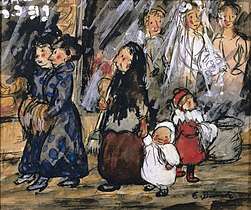 Bridal Shop, ca. 1913, watercolor, gouache, and charcoal on paper
Bridal Shop, ca. 1913, watercolor, gouache, and charcoal on paper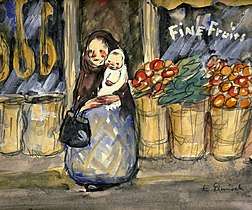 Fine Fruits, ca. 1913, watercolor, gouache, and charcoal on paper
Fine Fruits, ca. 1913, watercolor, gouache, and charcoal on paper Mother and Daughter, ca. 1913, watercolor, gouache, and charcoal on paper
Mother and Daughter, ca. 1913, watercolor, gouache, and charcoal on paper
In 1928 her watercolor Contemporary portraits were shown with Beaulah Stevenson's at the Whitney Studio Club and were then part of a traveling show to the Art Students League in New York, Fogg Museum of Art, Denver Art Museum, Minneapolis Institute of Arts, the California Palace of the Legion of Honor in San Francisco, and the Arts and Crafts Club in New Orleans.[21] The Whitney Studio Club, led by women patrons, held a solo exhibition of Dimock's work.[14][22]
References
- Petteys, Chris, Dictionary of Women Artists: An international dictionary of women artists born before 1900, G.K. Hall & Co, Boston, Ma, 1985
- Ronald G. Pisano; Marjorie Shelley. William Merritt Chase: Portraits in oil. Yale University Press; 2007. ISBN 978-0-300-11021-0. p. 143.
- Ira Glackens. William Glackens and the Eight: The Artists Who Freed American Art. Writers & Readers Pub. in association with Tenth Avenue Eds.; 1 September 1990. ISBN 978-0-86316-076-9. p. 33.
- All in the Family Paintings and Works on Paper by Members of the Glackens Family. ArtSlant Miami. Retrieved April 28, 2014.
- Bennard B. Perlman, The Immortal Eight; American Painting from Eakins to the Armory Show (1870-1913). New York: Exposition Press, 1962. p. 130. Accessed via Questia, an online subscription service.
- Wilson H. Faude. West Hartford. Arcadia Publishing; 1 January 2004. ISBN 978-0-7385-3486-2. p. 87.
- Marian Wardle. American Women Modernists: The Legacy of Robert Henri, 1910-1945. Rutgers University Press; 2005. ISBN 978-0-8135-3684-2. p. 101.
- Helene Barbara Weinberg. American Impressionism and Realism. Metropolitan Museum of Art; 2009. ISBN 978-1-876509-99-6. p. 74.
- Ann Lee Morgan Former Visiting Assistant Professor University of Illinois at Chicago. The Oxford Dictionary of American Art and Artists. Oxford University Press; 27 June 2007. ISBN 978-0-19-802955-7. p. 181.
- Deborah J. Johnson; David Ogawa; Kermit Swiler Champa. Seeing and Beyond: Essays on Eighteenth- to Twenty-first Century Art in Honor of Kermit S. Champa. Peter Lang; 1 January 2005. ISBN 978-0-8204-7084-9. p. 267.
- Deborah J. Johnson; David Ogawa; Kermit Swiler Champa. Seeing and Beyond: Essays on Eighteenth- to Twenty-first Century Art in Honor of Kermit S. Champa. Peter Lang; 1 January 2005. ISBN 978-0-8204-7084-9. p. 265.
- Carol Clark. American Drawings and Watercolors. Metropolitan Museum of Art; 1992. ISBN 978-0-87099-639-9. p. 168.
- Elizabeth Crawford, The Women's Suffrage Movement: A Reference Guide, 1866-1928. London: UCL Press, 1999. p. 442.
- Kathleen D. McCarthy. Women's Culture: American Philanthropy and Art, 1830-1930. University of Chicago Press; 1991. ISBN 978-0-226-55583-6. p. 236.
- Marian Wardle. American Women Modernists: The Legacy of Robert Henri, 1910-1945. Rutgers University Press; 2005. ISBN 978-0-8135-3684-2. p. 105.
- Kirsten Swinth. Painting Professionals: Women Artists & the Development of Modern American Art, 1870-1930. UNC Press Books; 2001. ISBN 978-0-8078-4971-2. p. 175, 256.
- The Annual American Catalog. Publishers' Weekly; 1906. p. 82.
- Kate Forrest Oswell. Stories Grandmother Told. Macmillan; 1912.
- Abraham A. Davidson, Early American Modernist Painting, 1910-1935. New York: Harper & Row, 1981. p. 166. Accessed via Questia, an online subscription service.
- 1913 Armory Show 50th Anniversary Exhibition, 1963 Henry Street Settlement, NY 1963 p. 188
- Lloyd Goodrich and John I. H. Baur, American Art of Our Century. New York: Praeger, 1961. p. 302. Accessed via Questia, an online subscription service.
- Patricia Bradley. Making American Culture. Palgrave Macmillan; 15 September 2009. ISBN 978-0-230-10047-3. p. 108.